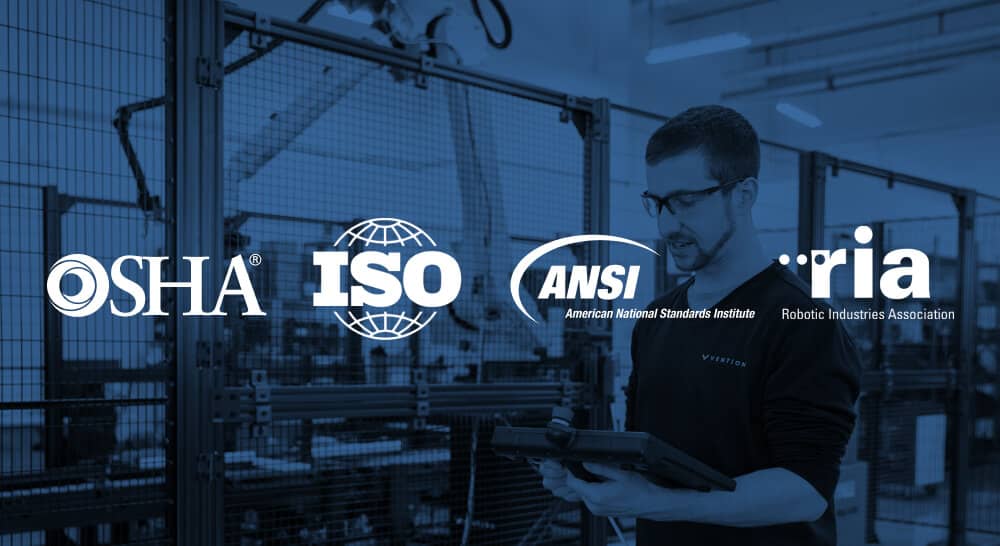Five safety standards you should know when deploying your first cobot cell

Safety is an important consideration for any cobot cell deployment, as local regulating bodies have requirements that must be met before robotic equipment can be put into production.
For example, US manufacturers are subject to OSHA requirements and must comply with ANSI/RIA standards. In Europe, compliance is according to the Machinery Directive (MD), which calls for the use of harmonized standards (compliance with the MD is the minimum requirement for CE-marking of industrial machinery).
Generally speaking, there is a correspondence between ANSI/RIA, European harmonized standards, and ISO standards.
Here are five safety-related documents you should consult when deploying your first cobot cell:
- RIA R15.06: Industrial Robots and Robot Systems- Safety Requirements (adoption of ISO 10218-1 + ISO 10218-2)
- RIA TR R15.606: Industrial Robots and Robot Systems - Safety Requirements - Collaborative Robots (adoption of ISO/TS 15066)
- RIA TR R15.306: Task-Based Risk Assessment Methodology (aligned with EN ISO 12100)
- RIA TR R15.406: Safeguarding (refers, among others, to ISO 13855 and ISO 13857)
- EN ISO 13849-1 and ISO 13849-2: Safety-related parts of control systems
Additional ISO documents relevant to the safety of machinery.
1. Safety requirements for industrial robots
RIA R15.06 (ISO 10218-1 + ISO 10218-2
This type-C standard is a good starting point when working with industrial robots or cobots and absolutely necessary if you intend to deploy a robot cell. It specifies requirements for safe designs, protective measures, and describes basic hazards associated with robots and provides requirements to eliminate or adequately reduce the risks associated with these hazards.
2. Robots and robotic devices - Collaborative robots
RIA TR R15.606 (adoption of ISO/TS 15066)
This Technical Report/Specification supplements RIA R15.06 (ISO 10128-1/2) by providing additional guidance for collaborative robots. Cobots have safety functions/features that often relax safety requirements, such as shrinking the overall size of the safety system or allowing the robot to continue operating with a human in the workspace. While the overall application ultimately determines the safety of the system—for example, a cobot holding a sharp object while moving is not considered collaborative—cobots greatly simplify a cell designer’s life in many cases, especially for pick-and-place operations.
3. Task-Based Risk Assessment Methodology
Making sense of all applicable standards and guidelines can be daunting. This task-based risk assessment methodology can help with that, defining a set of procedures for identifying hazards and evaluating risks during relevant phases of the machine life cycle and for eliminating or mitigating these risks in compliance with the relevant robot system norms. Guidance is also given on documenting and verifying the risk assessment and reduction process.
4. Safeguarding
RIA TR R15.406 (ISO 13855, ISO 13857, and others)
To mitigate the risk a robotic system can pose to humans, you often have to restrict access to the robot workspace. This document explains how to position safeguards to protect humans working in the vicinity of robots in an industrial environment. It considers the speed of approach for different parts of the human body (such as the head vs. the hands) and the type of safeguarding device (such as light curtains or fixed guarding), and then provides a methodology to determine minimum distances from the hazard zone.
5. Safety-related parts of control systems
The reliability of safety devices is critical to reaching the required level of safety based on the risk assessment. This family of standards helps determine the performance level (PL) of the safety functions implemented in your robot application. For example, the emergency stop function or a collaborative mode triggered by an area scanner.
In Conclusion
It’s important to consider safety during the design process of a cobot cell to avoid surprises at the deployment phase or, if applicable, the certification phase. Although these five safety standards are not an exhaustive list of all safety considerations for more complex applications, they cover most simple pick & place cobot applications. If you’re serious about deploying robots or cobots on your factory floor, you will want to get familiar with them.
Note that responsibility for meeting safety requirements rests with whoever is deploying the robot cell. For systems deployed entirely by Vention or a CSI partner, the safety evaluation and compliance are performed by Vention or the CSI and jointly agreed upon during initial on-site deployment with the plant safety manager.


